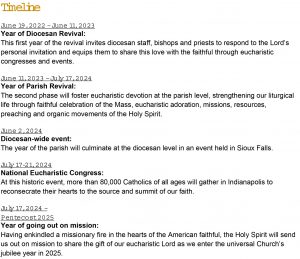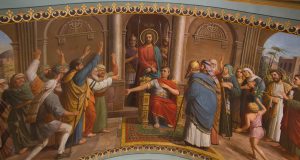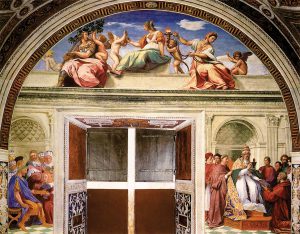
By Wendy Roytson
Over the next three years, Catholics across the country will be united in reviving what research shows (both locally and around the globe) has been declining steadily among Catholics: a devotion to the real presence of Jesus in the Eucharist.
“In 2017, a Pew Research poll showed that one-third of Catholics could identify the actual teaching of the Church surrounding the holy Eucharist,” said Father Scott Traynor, vicar for lay and clergy formation at the Diocese of Sioux Falls.
That teaching, summarized by the theological term “transubstantiation,” is the Catholic teaching that when an ordained priest prays the words of institution—this is my body; this is my blood—the bread and wine are truly transformed into the body and blood of Jesus, while continuing to retain the appearance of bread and wine.
“Many, many Catholics don’t know that or [they] think it’s just a symbol,” Father Traynor said, presenting a “crisis of faith and understanding. … You can’t assent in faith to what you haven’t even heard of,” and a decreased understanding of the Eucharist has led to declined Mass attendance.
Father Traynor said the very thing that makes the Eucharist miraculous is the thing that makes it hard to understand.

“There are all sorts of times where a substance becomes a different substance. When hydrogen and oxygen come together, they become water, and they don’t look like hydrogen and oxygen anymore. Their appearance and (accidental) properties change … when there’s a change in substance,” he said. Conversely, in the Blessed Sacrament, the change is not obvious. “The substance of the bread and the substance of the wine become the substance of Jesus, body, blood, soul and divinity, but retain their appearance.
“The retaining of the appearance is actually the miracle,” Father Traynor said. “Sometimes we hear about eucharistic miracles, where the host turns into a piece of flesh that bleeds, for example. That is a whole other category of miracle … because that’s just flesh and blood.”
But the entirety of the Real Presence cannot be seen by the human eye.
“It becomes the body, blood, soul and divinity of Jesus. It becomes all of Jesus, in a way that he can actually communicate himself to us as the Bread of Life,” Father Traynor said.
U.S. bishops face the challenge
In order to counteract the decline in understanding of the basic teachings of the Church, the bishops of the United States have organized what Father Traynor terms “a really proactive pastoral response.”
The feast of Corpus Christi, this past June 19, kicked off the bishops’ three-year Eucharistic Revival. The nationwide effort is intended to unite parishes and dioceses in pursuing the U.S. Conference of Catholic Bishops (USCCB) vision: “To form a movement of Catholics across the United States, healed, converted, formed and unified by an encounter with Jesus in the Eucharist, and sent out in mission for the life of the world.”
“It’s really kind of an unprecedented effort where the bishops of the United States have recognized this pastoral need and come up with a very creative and practical way to meet it,” Father Traynor said. “The pastoral need is that … both Mass attendance and people’s understanding of the actual teaching of the Church around the holy Eucharist has been famously on the decline for some time.”
A closing celebration of the revival’s mission, “to renew the Church by enkindling a living relationship with the Lord Jesus Christ in the holy Eucharist,” will be held in July 2024. That event, which Father Traynor described as “a World Youth Day-scale event,” is expected to draw more than 80,000 Catholics to Indianapolis, Indiana.
Bishop Andrew Cozzens of the Diocese of Crookston (Minnesota) is leading the revival. He envisions a nationwide movement in which the Holy Spirit ignites a fire for the faith in families and parishes that spreads to dioceses and archdioceses, eventually rekindling a love for Jesus in the Eucharist across the nation and around the globe.
Father Traynor said Bishop Cozzens often tells those involved in the revival, “I just want to start a forest fire, and I want arsonists everywhere. You guys just go out and start fires.”
“He does not desire a top-down approach with prescribed methods and training,” Father Traynor said. “Instead, sharing the mission and vision and encouraging grassroots efforts from the parish level.”
He summed up the direction of the movement as a proposition to the leaders of dioceses, parishes and Catholic organizations: “In what you do anyway, what can you do to offer and serve the Church, either in your area or across the country, to promote this mission and vision?”
Road to revival
The first year of the revival is the Year of the Diocese. The USCCB is asking dioceses across the country to promote the revival’s mission in creative ways.
In the Sioux Falls Diocese, inspiration is being sought through a diocesan steering committee, along with the collaboration of committees of priests and lay people in each of the six deaneries, making plans at the regional level. Additionally, each parish priest has been asked to form a core team of parishioners who are poised to lead the revival.
“We really just want to trust in the inspiration of the Holy Spirit and the different gifts and resources that people have to make this mission and vision a reality in our diocese,” Father Traynor said.
How that will actually play out remains to be seen, but Father Traynor said he imagines “beautiful nights” of praise and worship with confessions, Mass, adoration and uplifting music.
The second year will be the Year of the Parish, during which the ideas generated across the diocese and the events held at the diocesan level will be implemented in its parishes.
Throughout the course of the revival, efforts will be measured against five strategic pillars:
- Fostering encounters with Jesus through kerygmatic (basic Gospel message) proclamation and experiences of eucharistic devotion
- Contemplating and proclaiming the doctrine of the Real Presence through the truth of our teaching, the beauty of our worship and the goodness of a life of service
- Empowering grass-roots creativity with movements, apostolates, institutions and parishes
- Reaching the smallest units
- Embracing and learning from various intercultural eucharistic traditions
The revival will focus on fostering encounters with Jesus through kerygmatic proclamation and experiences of eucharistic devotion. Simplified, Father Traynor said, “God created us to be in friendship with him, but we denied the relationship through sin. … That calls for a personal response lived out in the Church. … The kerygmatic proclamation is really seeing how things are going in your life and seeing what they long for more and reminding that Jesus is the way to find that fulfillment, in the Eucharist.”
Another pillar of the revival is to contemplate and proclaim the doctrine of the Real Presence through the truth of our teaching, the beauty of our worship and the goodness of a life of service.
“Goodness, truth and beauty is what causes the heart to fall in love,” Father Traynor said. “We want people to know what we proclaim and believe about Jesus in the Blessed Sacrament, and that’s through teaching, but it’s also through witness of the beauty of our worship and through the goodness of service.”
He said this gets to the heart of reaching non-practicing Catholics, who might self-identify within the fastest-growing segment of Christians, according to Pew Research: the nones—those who believe in the teachings of Jesus but who chose not to identify with a formal religious tradition.
“To people who are at that threshold of conversion, who basically lack trust, let alone a curiosity and openness to what the Church has to say, the most effective evangelizing we can do is to be able to give the witness of being a good human being to them,” Father Traynor said.
The best way to accomplish this is for individual Catholics to embody what the Church has done for centuries.
“On a daily basis, we care for more sick people, visit more imprisoned people, educate more people, shelter more homeless people, feed more hungry people than any combination of organizations in the world,” he said. “That’s motivated out of love for Jesus (who) loves each of these people in their needs and, as his disciples, we should give witness to that by our own service.”
The revival also strives to empower grass-roots creativity with movements, apostolates, institutions and parishes and to reach the smallest units.
“It’s not just at the diocesan level, but every parish, every group in the parish, every family in the parish we want to be touched by this revival and make a response in their orbit,” Father Traynor said.
Father Traynor said each year, 80,000 Vietnamese Catholics hold their own eucharistic celebrations in the United States. The USCCB intends to embrace and learn from various intercultural eucharistic traditions and the joy they share in their celebration and bring it to the multicultural Catholic stage with the closing celebration in 2024.
Why does all of this matter here?
Father Traynor said the Eucharistic Revival is the product of “divine prompting” that proves “God is on the march, and he is taking good care of the Diocese of Sioux Falls as he’s lined up all of this.”
When Bishop Donald DeGrood prayed about his appointment to the Sioux Falls Diocese prior to arriving in February 2020, Father Traynor shared, he was “well aware of the statistics of decline” and prayed about how he could shepherd the people of East River South Dakota in a way that would counteract the trend. “Marginally managing decline while staying slightly better than our neighbors isn’t Bishop Donald DeGrood. … He is a man of hope and optimism and trust in the Lord.”
In a spirit of trusting that the Lord would provide whatever his flock needed, Bishop DeGrood prayed, according to Father Traynor, that the diocese would thrive under his leadership.
“That was really the catalyst for the vision of our diocese to form a culture of Lifelong Catholic Missionary Discipleship Through God’s Love,” Father Traynor explained.
“That isn’t just ‘word salad’ … this is really what we see in the Gospel. When Jesus is proclaiming the kingdom, his proclamation is always accompanied by acts of divine power. He heals the blind and the lame and the leprous and the mute … and that healing is at the service of a spiritual conversion. [Similarly], people are healed by encounters with Jesus in the Eucharist at Mass. … The power of Jesus Christ to physically, emotionally, psychologically and spiritually heal is present in the Blessed Sacrament at every Mass,” Father Traynor said, citing numerous examples from his own priesthood of changes made in people’s lives after encountering the Eucharist.
And “through God’s love isn’t just a pretty flair at the end of the statement,” he said. “It’s really the foundation, the goal and the fabric against which the rest of that mission and vision is woven, because the only thing that causes me to want to be a disciple of Jesus is experiencing his love. The only adequate motivation to want others to know and love Jesus is Christ’s own love for them.
“The only fruitful cause for evangelization is being caught up in Jesus’s love for each person, and … being missionary disciples is all rooted and ordered to love,” Father Traynor continued. “So, beginning, middle and end, it’s all about love. The sacrament of the holy Eucharist is the sacrament of Christ’s redemptive love. No greater love is there than this, to lay down one’s life for one’s friends. It’s that redemptive love—Christ’s sacrifice on the cross—that’s made present and effective at every Mass. The Eucharist is the sacrament of Christ’s redemptive love, so, of course, it’s at the heart of our growing in our diocesan vision of Lifelong Catholic Missionary Discipleship Through God’s Love.”
A few months after Bishop DeGrood came to Sioux Falls and introduced his divinely inspired vision, the University of Mary released a book, “From Christendom to Apostolic Mission,” that addressed the reasons behind the Church’s struggles.
“That book gives the background of why this vision of organizing the efforts of our diocese to form lifelong Catholic missionary disciples through God’s love … is necessary. We don’t live in Christendom anymore—we’re living in an apostolic age—and if we’re just drifting along with the stream, we’re going to continue to decline,” Father Traynor said, summarizing the 94-page book more than 5,000 Catholics in the diocese studied in 2021. “That book and the study that we were able to do … really gave the ‘why’ behind the ‘what’ of our vision, which was a great grace.”
The graces continued to flow when Pope Francis called for a three-year Synod on Synodality in October 2021.
“The heart of the Synod on Synodality was to have intentional conversations with people and just see what God is raising up in the hearts of the people,” Father Traynor explained, adding that the synod’s goal really mirrored Bishop DeGrood’s goal locally and magnified it to a universal level.
As a response to the pope’s call and to include input from as many of its members as possible, the Sioux Falls Diocese created an online survey and facilitated discussion sessions in parishes across the diocese.
The 4,000 surveys collected showed two major themes: an ache in the hearts of East River Catholics to make greater, more intentional efforts to reach non-practicing Catholics, especially men, whose practice of the faith has shown a significant impact on their children’s adult spirituality in numerous studies since the 1990s.
And the other theme?
“The most treasured piece of our faith is the Eucharist,” Father Traynor said. “Even if we have terrible music and awful preaching, we have the Eucharist, and that’s what we treasure as Catholics.”
Just as the diocese was getting a grasp on the results of the survey and searching for ways to counteract the concerns it presented, the U.S. bishops announced their vision.
“Of all the things they could do to promote lifelong Catholic missionary discipleship through God’s love … the centrality of the Eucharist emerges, and how we can get more people connected to our Catholic faith by encountering Jesus in the Blessed Sacrament,” Father Traynor said.
He connected more dots of God’s evident plan, saying the events that have unfolded since February 2020 prove that God is authoring the Catholic story in our diocese and the world.
“New bishop, this vision, here’s the cultural reason of why the vision’s so important, here’s a chance from the universal church—from the pope—to have really good discussions … and what did we learn? This intense focus on the Eucharist and then, lo and behold, the U.S. bishops invite us to an intense focus on connection to Christ in the Eucharist as the hinge of renewing the Church. … That is crazy-detailed providence,” Father Traynor said. “That excites me to no end, to see what God is going to raise up as we now move into this phase of the Eucharistic Revival.”


